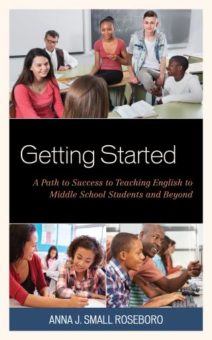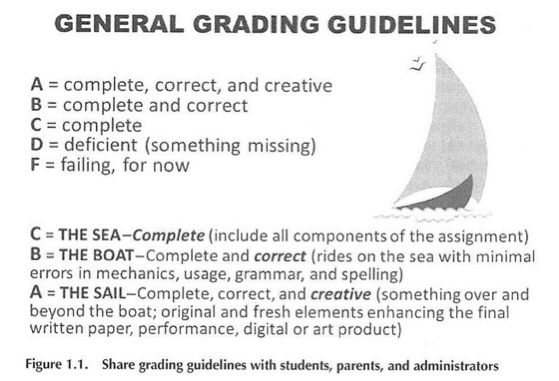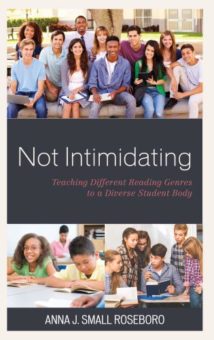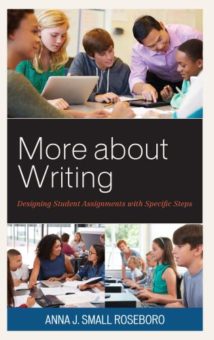Teaching English in the Middle School Years
Getting Started: A Path to Success to Teaching English to Middle School Students and Beyond
Not Intimidating: Teaching Different Reading Genres to a Diverse Student Body
More about Writing: Designing Student Assignments with Specific Steps
By Anna J. Small Roseboro
(Rowman & Littlefield, 2019 – Learn more)

Anna J. Small Roseboro offers educators a trio of books filled with an assortment of strategies for teaching middle school students. Both veteran and beginning teachers will find any of these titles useful. While there is some overlap in techniques, sample lessons, and artwork, each book has a distinct focus and includes practical suggestions for meeting specific learning needs of middle school students.
So, which book meets your needs?
Getting Started: A Path to Success to Teaching English to Middle School Students and Beyond is a valuable resource for anyone entering education in a nontraditional manner.
Not Intimidating: Teaching Different Reading Genres to a Diverse Student Body is an excellent choice for anyone seeking literacy strategies and activities to engage adolescents.
More about Writing: Designing Student Assignments with Specific Steps is the appropriate choice for anyone seeking strategies and activities for teaching writing,
An administrator will find all three titles useful; however, select the title that best meets your building’s needs. Anyone working with preservice teachers (or seeking middle school certification) will find Getting Started an appropriate choice because it presents an overview of teaching in middle school.
Let’s look at each book in more detail.
Getting Started: A Path to Success to Teaching English to Middle School Students and Beyond

For classroom management to be effective, she suggests a few general rules or guiding principles related to attendance, homework, and student behavior. She offers common sense advice: “Begin the school year the way you would like it to continue throughout the year.” (p. 9)
And if that’s not enough, in Chapter 1 she discusses grading principles as noted in Figure 1.1 on page 11.

The remaining seven chapters are filled with activities, instructional benefits, and academic connections related to the reading, writing, speaking, and listening standards set for middle school students. This book can serve as a resource for teachers who often find themselves overwhelmed by the amount of reading and writing required in one school year. Roseboro includes a variety of assignments that engage students and prepare them for high school and beyond.
Not Intimidating: Teaching Different Reading Genres to a Diverse Student Body

Chapter 2, Unpacking the Story and Understanding the Genre, is filled with instructional ideas “to introduce students to the basic elements of fiction by reading short stories, and analyzing plot structures and characterization.” (p.25) Once students understand the elements of literature and have a common vocabulary, she suggests moving on to reading longer fiction.
Chapter 3 contains a wealth of ideas for teaching longer works of fiction like Richard Peck’s A Day No Pigs Would Die. In Chapter 4 she suggests ways to increase student interest in classical fiction using A Christmas Carol by Charles Dickens. The text chosen for teaching historical fiction is I, Juan de Pareja by Elizabeth Borton de Trevino.
The assignments range from formal to informal speaking or writing and often include the use of available technology. For Roseboro it is about more than passing a test; she designs lessons to help adolescents learn about human beings and the world.
Roseboro selects Cyrano de Bergerac by Edmond Rostand and Romeo and Juliet for teaching a work of drama. Her suggestions for journaling, annotating, and note-taking will help students grow confident in reading drama.
Roseboro does not disappoint in the final chapter where she addresses the broad genre of Nonfiction, particularly essays, speeches, and the media. Readers will find ideas for teaching students how to use text structure, how to use signal words, and how to consider purpose and audience.
More about Writing: Designing Student Assignments with Specific Steps

As in her previous books, Roseboro encourages teachers to plan with the school calendar in mind in order to maximize learning. She suggests an activity for the beginning of school designed to build a community of writers in the classroom. As students read, research, and write about their names, they are also participating in conferences and peer editing sessions.
Chapter 4 is devoted to writing in the content areas as a means of “expressing, exploring, and expanding our understanding.” (p.35) She suggests assigning three kinds of writing on a regular basis: expressive, exploratory, and discovery. Readers will find writing-to-learn activities throughout the chapter. And do not overlook what she says on page 35: “…writing for this purpose does not have to be collected, read, or graded.”
Her common sense approach to writing is evident as she tackles an issue many teachers face: how to address the standards and requirements set by the district or state yet still allow students to express themselves. She reminds teachers to teach the academic vocabulary that appears on standardized tests. With careful planning and preparation, these adolescent learners can grow into the “sophisticated thinking required to write convincing arguments and persuasive essays and speeches.” (p.69)
Engaging students in writing poetry becomes easier with a delightful culminating activity the author calls Lazy Sonnets. Students compose a poem of 14 words to capture “a key idea and show the characters, conflicts, or a theme of the fiction or nonfiction piece.” (p.96)
For students who struggle to come up with story ideas, Chapter 8 is crammed with suggestions. Ideas for mini-lessons relating to conflict and character development along with suggestions for grading during the composition process benefit both new and veteran teachers. For those teachers who want their students to draft one-act plays, refer to Chapter 9. The final chapter, Write for Public Speaking and Media, provides additional ideas and suggestions to foster the writing habit.
Three books to benefit you and your students
Anna Roseboro packed all three books with valuable instructional strategies and worthwhile activities. It is almost too much of a good thing! This is not light reading, especially since the font is small. Whether you choose to explore all three books, or only one, you and your students will benefit.
Former eighth grade teacher Anne Anderson is an educational consultant known for her practical ideas and engaging ELA workshops. Anne’s goal is to help teachers help students. Her positive approach and sense of humor bring encouragement to her audiences. She loves showing teachers how to use whatever resources they have – or don’t have – to enhance learning. Anne seeks to provide educators with practical solutions to teaching and learning problems. Visit her website and subscribe to her bi-monthly newsletter, Spotlight on Success.





































